
1938 Definitive Set
Updated - November, 2018
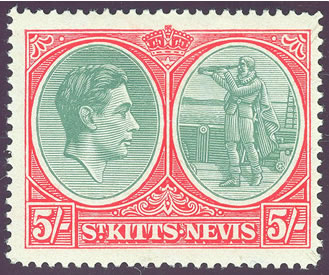
Identifying the St. Kitts-Nevis 1938 Set issues is very complicated. There were a number of printings, many of which are not catalog listed, so as you compare stamps you might find some variation that does not exactly fit the catalog listings. You will find variations in the perforations, color, paper type, and the gum. This is a set that requires multiple copies in order to properly study it. The set was in use from 1938 until it was replaced with a new design in 1952.
There are three different formats for the stamps. The lower values (1/2d, 1d. 1-12d. and 2-1/2d) are all printed in a smaller format that varies primarily in color, but you might also notice that there is some difference in the paper and gum as you look at a number of them. The large format stamps were only used for the two high values (10/ and £1) which were only printed one time, so there is nothing to study there. The really interesting stamps are the middle values (2d, 3d, 6d, 1/, 2/6 and 5/). These are the stamps you will want to study, and most of the comments below apply to these stamps.
Two different perforations were used for the middle value stamps. The initial printing was perforated 13 x 11.75 using a comb perforator which punches holes in three sides of the stamps at once. Beginning in 1941, the stamps were perforated 14 using a line perforator which punches one line at a time. I start the identification process for these values by comparing the perforations first. I recommend that you use a gauge like the Stanley Gibbons Instanta Gauge to determine the perforation. It is much more reliable because it uses a continuum of lines rather than pre sized dots like some of the other gauges, so you get a more exact measurement rather than a guess.
Once you have determined the perforations, you need to determine whether the paper is chalk coated or substitute (no chalk). Chalk coating was used because it left a better impression. It is not really chalk, but that is the common name for the coating. Testing for chalk costing can be done using a piece of silver for the later printings. Drag it lightly over one of the margins and a pencil like line will appear. (The later chalk paper printings below will have these pencil like lines on them.) You can also rub your finger over the paper. Chalk paper will tend to feel slick whereas substitute paper will tend to drag. Another option is to look at the paper under a strong light or under magnification. The impression of the stamp on chalk paper is better than substitute paper. You might also notice that the coating will tend to be seen on chalk coated stamps from this Colony.
After you sort your stamps by perforation and into paper types, you can start looking at the gum. I compare gum by putting the stamp face down on black paper. The early printings tend to have a more off-white or yellowish colored gum, and the later printings tend to be on a brighter white paper. If you are lucky enough to find stamps from the 1941 printing, you should notice that the gum is off-white and tends to have horizontal ridges in it making it look almost like lines. The 1941 printings were on chalk paper, but the silver test does not work as well on these issues, so use the gum to confirm this printing. As you check the gum on your stamps you may note that the watermark is sideways. That is normal for these values.
After you have observed the other factors, look at the color of the stamps. Many collectors have trouble identifying colors. I find it helps to have a number of stamps to sort rather than just one or two. I place all of the same value stamps on black and then white paper and look at them under a strong light. The color differences tend to stand out when viewed this way. Then it becomes a matter of deciding if a stamp is a darker or paler in comparison to the other stamps in the group you are sorting. When you have isolated the color differences, look at your catalogue reference to see what is listed. Remember there were multiple printings of this set, so there should be some variation in many of the values. You can use the stamps shown below as a reference of what might be found.
Unlike modern stamps which are issued in the millions, definitive sets from this time period were issued very conservatively. Luckily we have the quantities printed from the Crown Agents reports which was included in "A Study of the King George VI Stamps of St. Kitts-Nevis 1938-1950" by Peter L. Baldwin which was published by Murray Payne in 1997. Not counting the 10/ and £1 values which are excluded from the book, 78,900 5/ stamps were printed in total. The 1941 printing is the rarest with only 6,300 stamps produced all of which were sent to the Colony. Please refer to Peter Baldwin's publication if you want more information on these issues.
The printing dates used below are from Peter Baldwin's monograph mentioned above. Some catalog values might actually include as many as five printings. So it can be difficult to correlate the printings listed with each of the catalog numbers. Where a single catalog value represents multiple printings, all of the year dates will be shown. Please be aware that it is virtually impossible to correctly assign every printing to the lower value catalog numbers completely accurately. For my purposes, the 1938 lower value printings tend to be on paper with a yellowish gum, and the later ones are more white or off-white. So I assign the dates accordingly.
The catalog numbers and descriptions are from the 2008 Commonwealth King George VI Postage Stamp Catalogue (CW) published by Murray Payne. The 2013 Stanley Gibbons Stamp Catalogue (SG) and the 2011 Scott catalog (ST) are included for cross reference purposes. You can access the publishers using the "Links to British Colonial Stamp Sites" at the bottom of this page. If you have both the Commonwealth and Gibbons Catalogues, you will notice that the dates don't match for some of the issues. That is because Gibbons is indicating the earliest usage for their dates while Commonwealth is indicating the despatch date that the stamps were sent to the Colony.
The images were saved in a larger size and at a higher resolution so you can more easily see the details used in sorting them. Please be patient if it takes a few minutes for this page to load. Although the two high values were issued first, the stamps are shown in value order below.
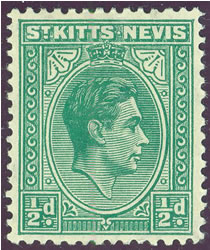 |
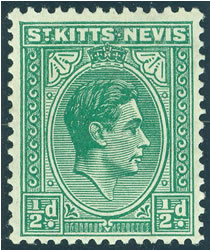 |
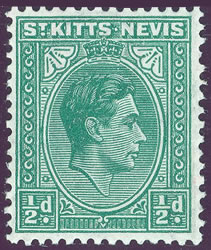 |
| CW 1 - SG 68 - ST 79 1/2d Green 1938 Printing |
CW 1a - SG 68 - ST 79 1/2d Deep Dull Green 1941, 1943, 1944, 1947 Printings |
CW 1b - SG 68a - ST 79 1/2d Dull Blue-Green 1949 Printing |
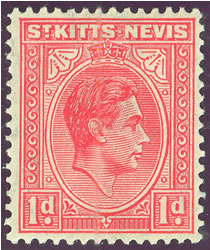 |
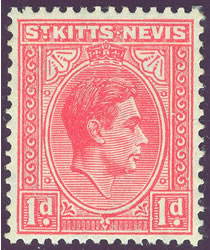 |
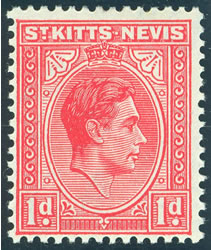 |
| CW 2 - SG 69 - ST 80 1d Red 1938, 1939, 1940 Printings |
CW 2a - SG 69a - ST 80 1d Deep Rose-Red 1943, 1945, 1947 Printings |
CW 2b - SG 69a - ST 80 1d Rose-Red 1941, 1942, 1944 Printings |
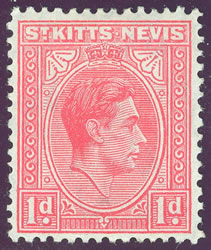 |
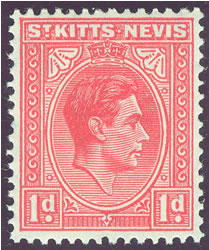 |
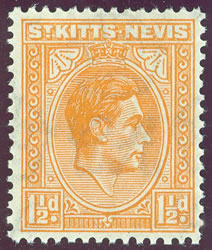 |
| CW 2c - SG 69b - ST 80 1d Rose-Pink 1947 Printing |
CW 2d - SG 69c - ST 80 1d Dull Rose-Red 1949 Printing |
CW 3 - SG 70 - ST 81 1-1/2d Orange 1938 Printing |
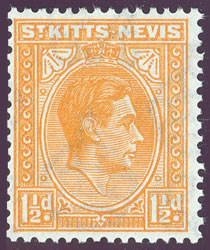 |
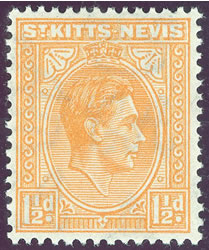 |
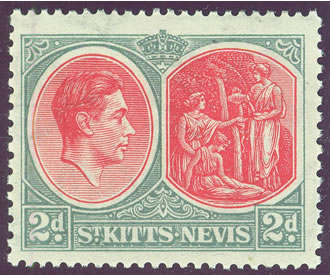 |
| CW 3a - SG 70 - ST 81 1-1/2d Dull Orange 1940, 1943, 1946, 1949, 1950 Printings |
CW 3b - SG 70 - ST 81 1-1/2d Pale Yellow-Orange 1944, 1947 Printings |
CW 4 - SG 71 - ST 82a 2d Scarlet & Grey Perf 13 x 11.75 Substitute Paper 1938 Printing |
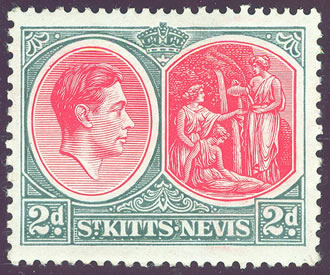 |
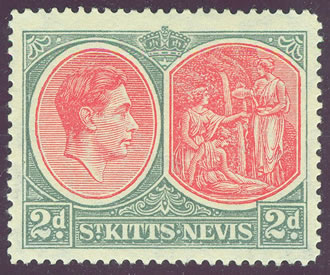 |
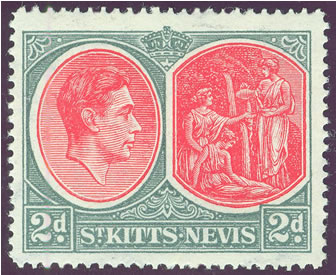 |
| CW 4a - SG 71a - ST 82a 2d Scarlet & Slate Perf 13 x 11.75 Chalk Paper 1940 Printing |
CW 11 - SG 71b - ST 82 2d Scarlet & Grey Perf 14 Substitute Paper 1941, 1943, 1944, 1948 Printings |
CW 11a - SG 71ba - ST 82 2d Scarlet & Deep Grey Perf 14 Substitute Paper 1942 Printing |
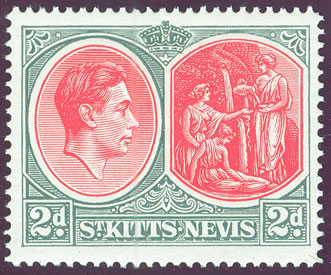 |
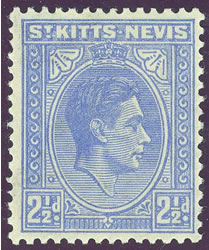 |
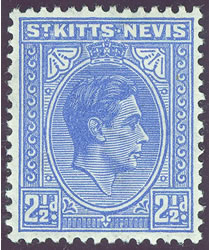 |
| CW 11b - SG 71c - ST 82 2d Scarlet & Grey Perf 14 Chalk Paper 1949 Printing |
CW 5 - SG 72 - ST 83 2-1/2d Pale Ultramarine 1938 Printing |
CW 5a - SG 72a - ST 83 1943, 1947, 1950, 1951 Printings |
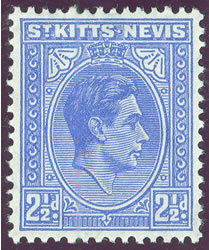 |
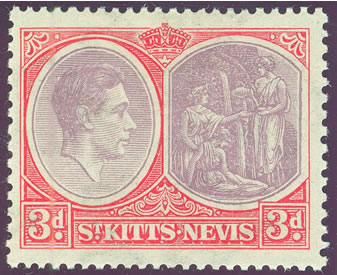 |
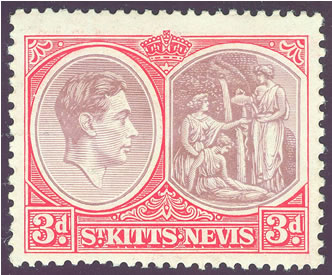 |
| CW 5b - SG 72a - ST 83 2-1/2d Bright Blue 1944, 1946, 1947, |
CW 6 - SG 73 - ST 84a 3d Dull Lilac & Dull Red Perf 13 x 11.75 Substitute Paper 1938 Printing |
CW 6a - SG 73a - ST 84a 3d Pale Dull Claret & Dull Red Perf 13 x 11.75 Chalk Paper 1940 Printing |
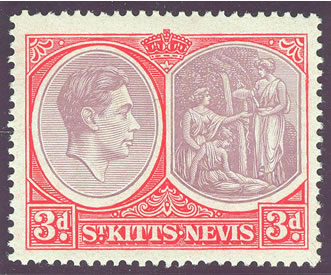 |
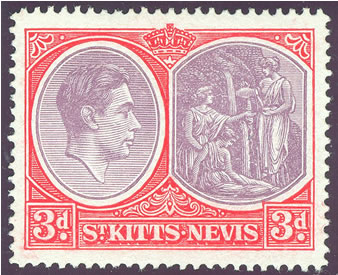 |
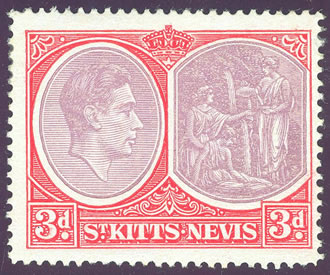 |
| CW 12 - SG 73b - ST 84 3d Dull Mauve & Scarlet Perf 14 Chalk Paper 1941 Printing |
CW 12a - SG 73d - ST 84 3d Reddish-Lilac & Scarlet Perf 14 Substitute Paper 1943 Printing |
CW 12b - SG 73c - ST 84 3d Dull Reddish-Lilac & Scarlet Perf 14 Substitute Paper 1945 Printing |
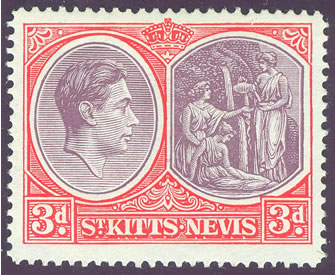 |
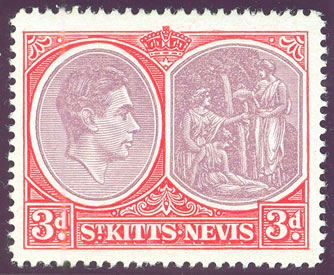 |
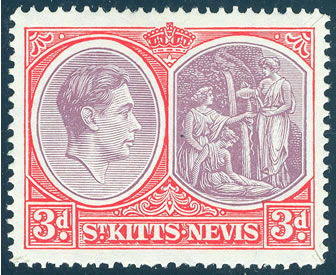 |
| CW 12c - SG 73e - ST 84 3d Deep Violet & Scarlet Perf 14 Chalk Paper 1946 Printing |
CW 12d - SG 73f - ST 84 3d Reddish-Lilac & Red Perf 14 Substitute Paper 1947 Printing |
CW 12e - SG 73g - ST 84 3d Pale Dull Rose-Lilac & Red Perf 14 Chalk Paper 1948 Printing |
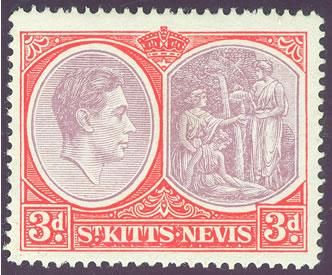 |
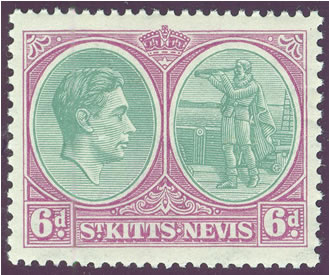 |
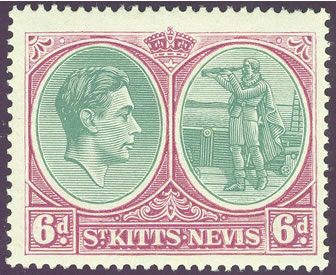 |
| CW 12f - SG 73g - ST 84 3d Dull Mauve & Vermilion-Red Perf 14 Chalk Paper 1950 Printing |
CW 7 - SG 74 - ST 85a 6d Dull Green & Deep Purple Perf 13 x 11.75 Substitute Paper 1938 Printing |
CW 13 - SG 74b - ST 85 6d Dull Green & Dull Claret Perf 14 Chalk Paper 1941 Printing |
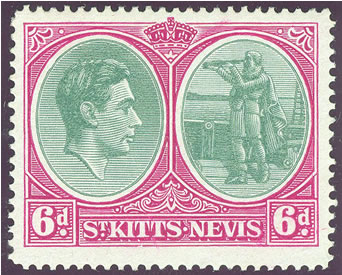 |
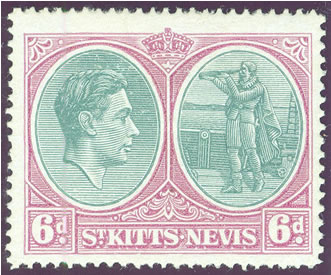 |
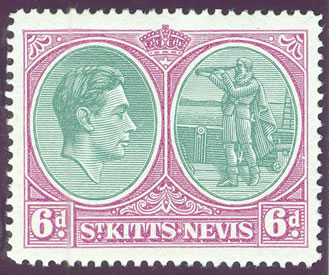 |
| CW 13a - SG 74c - ST 85 6d Dull Green & Deep Reddish-Purple Perf 14 Substitute Paper 1941 Printing |
CW 13b - SG 74c - ST 85 6d Pale Dull Green & Red-Purple Perf 14 Substitute Paper 1943, 1944, 1945, 1947 Printings |
CW 13c - SG 74c - ST 85 6d Pale Blue-Green & Pale Reddish-Purple Perf 14 Substitute Paper 1947 Printing |
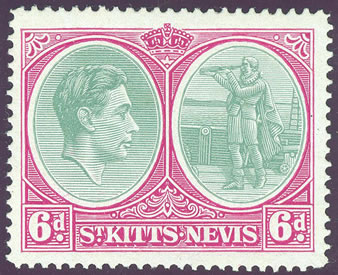 |
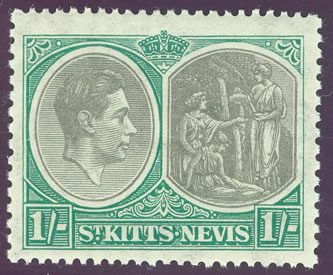 |
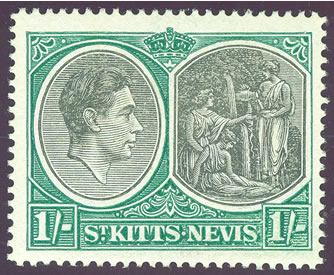 |
| CW 13d - SG 74d - ST 85 6d Pale Dull Green & Reddish-Purple Perf 14 Chalk Paper 1948, 1950 Printings |
CW 8 - SG 75 - ST 86a 1/ Greyish-Black & Green Perf 13 x 11.75 Substitute Paper 1938 Printing |
CW 14 - SG 75b - ST 86 1/ Black & Green Perf 14 Substitute Paper 1943, 1944, 1945 Printings |
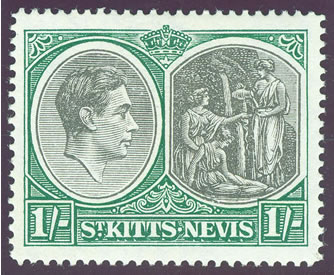 |
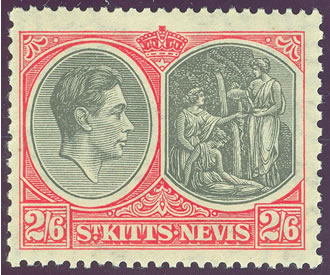 |
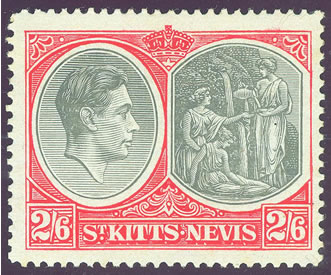 |
| CW 14a - SG 75c - ST 86 1/ Black & Green Perf 14 Chalk Paper 1949 Printing |
CW 9 - SG 76 - ST 87a 2/6 Greyish-Black & Red Perf 13 x 11.75 Substitute Paper 1938 Printing |
CW 15 - SG 76a - ST 87 2/6 Black & Scarlet Perf 14 Chalk Paper 1941 Printing |
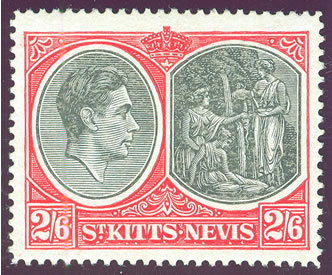 |
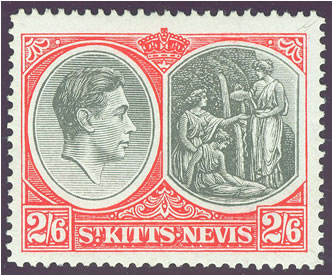 |
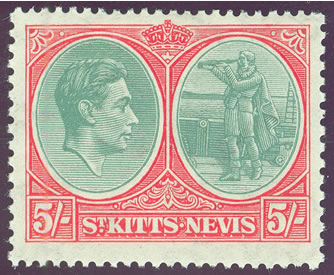 |
| CW 15a - SG 76ab - ST 87 2/6 Black & Scarlet Perf 14 Substitute Paper 1943, 1945 Printings |
CW 15b - SG 76a - ST 87 2/6 Black & Scarlet-Vermilion Perf 14 Chalk Paper 1949 Printing |
CW 10 - SG 77 - ST 88a 5/ Dull Green & Red Perf 13 x 11.75 Substitute Paper 1938 Printing |
 |
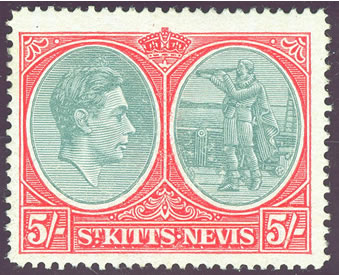 |
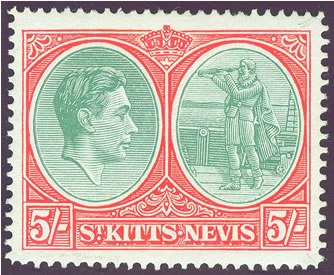 |
| CW 16 - SG 77a - ST 88 5/ Greyish-Green & Deep Rose-Red Perf 14 Chalk Paper 1941 Printing |
CW 16a - SG 77b - ST 88 5/ Dull Blue-Green & Scarlet Perf 14 Substitute Paper 1943, 1944, 1945 Printings |
CW 16b - SG 77c - ST 88 5/ Dull Green & Vermilion Perf 14 Chalk Paper 1950 Printing |
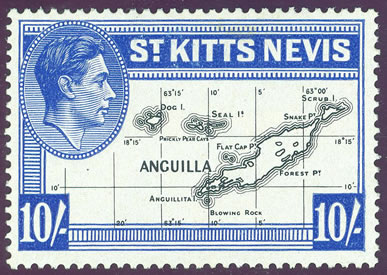
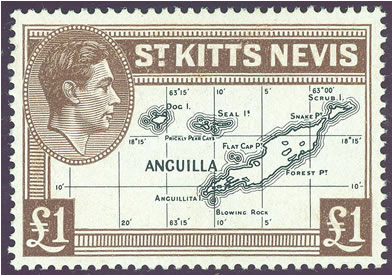
10/ Black & Deep Blue
1948 Printing
£1 Black & Chocolate-Brown
1948 Printing
This article was written to help you identify your stamps.
Please feel free to ask a question, or include a correction.